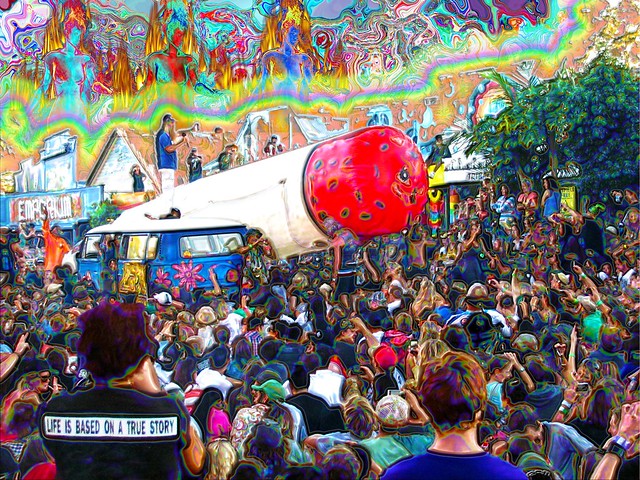Smoking Marijuana Doesn’t Cause Crashes
U.S.:
Pot use doesn't increase crash risk
by David Shepardson
A government study released last month found no evidence that marijuana use leads to a higher risk of getting into a traffic
crash.
But safety advocates believe it is still dangerous to drive after
smoking significant amounts of marijuana, and the government plans more
testing.
The National Highway Traffic Safety Administration said a 20-month
survey of drivers in 2013 and 2014 found that while drinking dramatically
raises the chance of a crash, there was no evidence that marijuana use is
statistically significant in boosting wreck rates.
The agency said the issue is of growing importance in the wake of
marijuana being legalized in Colorado, Oregon, Alaska and Washington state for
recreational use.
In Michigan, eight cities approved decriminalization measures last year
for marijuana: Berkley, Huntington Woods, Mount Pleasant, Pleasant Ridge, Port
Huron, Saginaw, Oak Park and Hazel Park.
The report's findings were based on two surveys. The National Roadside
Survey, which collected information from volunteer drivers at 300 research
checkpoints across the U.S., and a second study — the largest of its kind ever
conducted — that assessed whether marijuana use by drivers is associated with greater
risk of crashes. That study, in Virginia, gathered data over 20 months from
more than 3,000 drivers who were in crashes, as well as a comparison group of
6,000 drivers who did not crash.
The percentage of drivers with evidence of marijuana in their system
increased from 8.6 percent in 2007 to 12.6 percent in the study, NHTSA said
Marijuana users were about 25 percent more likely to be involved in a
crash than drivers with no evidence of marijuana use. But that's because other
factors — especially that more younger men are involved in crashes, NHTSA said
— rather than marijuana use itself.
By comparing marijuana use among those in crashes and those who weren't,
the safety agency said "other factors, such as age and gender, appear to
account for the increased crash risk among marijuana users."…
Mason Tvert, director of communications for the Marijuana Policy Project
in Denver, added that the group doesn't want people driving after significant
marijuana use.
"Nobody should drive while impaired by any substance, and that's
why there are laws on the books to address it. While the research is pretty
clear that marijuana use is not remotely as problematic as alcohol when it
comes to driving, it can cause impairment. We need to have laws that are
grounded in science and punish only drivers who were actually impaired. It's
worth noting that there is also research that has shown people who have used
marijuana are more likely to recognize if they are impaired than those who have
used alcohol," he said.
But he said police often go too far.
"Arresting hundreds of thousands of people for simply possessing
marijuana will not do anything to prevent people who make the mistake of
driving under the influence. We would never approach the problem of drunk
driving by making it illegal for adults to drink responsibly. It's just as
foolish to do that when it comes to adults who use marijuana responsibly,"
he said.
It's difficult to determine at what level marijuana use may impair
driving, the government said, because — unlike with alcohol testing — there
aren't precise levels of chemicals from marijuana proven to correlate with
impairment.
Drugged drivers
 Michigan had the 12th highest rate of drugged drivers in the country from 2006-09, says the Substance Abuse and Mental Health
Services Administration.
Michigan had the 12th highest rate of drugged drivers in the country from 2006-09, says the Substance Abuse and Mental Health
Services Administration.
While all states prohibit driving under the influence of drugs, there's
significant variation in the minimum acceptable levels of marijuana or its
traces in a driver's system.
Sixteen states, including Michigan, forbid any presence of prohibited
drugs, while five others have specific limits for marijuana. In October, Gov.
Rick Snyder signed legislation allowing police to conduct a roadside analysis
for drugs, in addition to alcohol.
Mothers Against Drunk Driving has made drug use behind the wheel a
bigger focus. MADD this year changed its mission statement to include
"help fight drugged driving."
"MADD hopes to bring awareness to the growing threat of drugged
driving on our roadways, much in the same way we have with drunk driving since
our founding in 1980," the group says on its website.
"While the substances are different, the results are the same —
needless deaths and injuries."
NHTSA is conducting additional studies to further understand the risk of
driving after drug use, including the Washington State Roadside Survey,
"which will assess risk in a state where marijuana has recently been
legalized."
It also is on board with the National Institute on Drug Abuse for a
simulator study to assess how drivers under the influence of drugs behave
behind the wheel, the agency said. Ongoing research, it said, "will refine
our understanding of when marijuana use by drivers" increases the effect
it has on driving.
"Researchers have developed a deep body of knowledge about the link
between drinking, driving and risk. We know drunk driving kills," added
NHTSA Administrator Mark Rosekind.
"The combined message of these two surveys is that our work to
understand and combat drunk driving is paying off, but that we have much to
learn about how illegal drugs and prescription medicines affect highway safety
— and that developing that knowledge is urgent, because more and more drivers
have these drugs in their systems."
Weekend numbers fall
As marijuana use behind the wheel is rising, the incidence of driving on weekends after drinking has fallen
sharply.
The study said the proportion of drunken drivers on the roads has fallen
by 80 percent since 1973. The study found about 1.5 percent of weekend drivers
had blood-alcohol concentrations equal to being legally intoxicated, 0.08
percent or above.
The proportion of drivers with any alcohol in their system declined by
about 30 percent from 2007 to 2014.
Drivers with a breath alcohol level of 0.08 percent were about four
times more likely to crash than sober drivers, NHTSA said, while drivers with
an alcohol level of 0.15 percent were 12 times more likely to crash than sober
drivers.
From The Detroit News @ http://www.detroitnews.com/story/news/nation/2015/02/06/us-evidence-marijuana-leads-higher-crash-risk/23004549/
Marijuana and Driving:
A Review of the Scientific Evidence
 by Norml
by Norml
It is well established that alcohol increases accident risk. Evidence of marijuana’s culpability in on-road driving accidents is much less convincing.
Although cannabis intoxication has been shown to mildly impair psychomotor skills, this impairment does not appear to be severe or long lasting. In driving simulator tests, this impairment is typically manifested by subjects decreasing their driving speed and requiring greater time to respond to emergency situations.
Nevertheless, this impairment does not appear to play a significant role in on-road traffic accidents. A 2002 review of seven separate studies involving 7,934 drivers reported, “Crash culpability studies have failed to demonstrate that drivers with cannabinoids in the blood are significantly more likely than drug-free drivers to be culpable in road crashes.” This result is likely because subject under the influence of marijuana are aware of their impairment and compensate for it accordingly, such as by slowing down and by focusing their attention when they know a response will be required. This reaction is just the opposite of that exhibited by drivers under the influence of alcohol, who tend to drive in a more risky manner proportional to their intoxication.
Today, a large body of research exists exploring the impact of marijuana on psychomotor skills and actual driving performance. This research consists of driving simulator studies, on-road performance studies, crash culpability studies, and summary reviews of the existing evidence. To date, the result of this research is fairly consistent: Marijuana has a measurable yet relatively mild effect on psychomotor skills, yet it does not appear to play a significant role in vehicle crashes, particularly when compared to alcohol. Below is a summary of some of the existing data.
(For more information on NORML’s position regarding marijuana, driving and the law, please click here or visit NORML’s Principles of Responsible Cannabis Use.)
“At the present time, the evidence to suggest an involvement of cannabis in road crashes is scientifically unproven.
To date ..., seven studies using culpability analysis have been reported, involving a total of 7,934 drivers. Alcohol was detected as the only drug in 1,785 drivers, and together with cannabis in 390 drivers. Cannabis was detected in 684 drivers, and in 294 of these it was the only drug detected.
... The results to date of crash culpability studies have failed to demonstrate that drivers with cannabinoids in the blood are significantly more likely than drug-free drivers to be culpable in road crashes. … [In] cases in which THC was the only drug present were analyzed, the culpability ratio was found to be not significantly different from the no-drug group.”
REFERENCE: G. Chesher and M. Longo. 2002. Cannabis and alcohol in motor vehicle accidents. In: F. Grotenhermen and E. Russo (Eds.) Cannabis and Cannabinoids: Pharmacology, Toxicology, and Therapeutic Potential. New York: Haworth Press. Pp. 313-323.
“Cannabis leads to a more cautious style of driving, [but] it has a negative impact on decision time and trajectory. [However,] this in itself does not mean that drivers under the influence of cannabis represent a traffic safety risk. … Cannabis alone, particularly in low doses, has little effect on the skills involved in automobile driving.”
REFERENCE: Canadian Senate Special Committee on Illegal Drugs. 2002. Cannabis: Summary Report: Our Position for a Canadian Public Policy. Ottawa. Chapter 8: Driving Under the Influence of Cannabis.
“This report has summarized available research on cannabis and driving.
… Evidence of impairment from the consumption of cannabis has been reported by studies using laboratory tests, driving simulators and on-road observation. ... Both simulation and road trials generally find that driving behavior shortly after consumption of larger doses of cannabis results in (i) a more cautious driving style; (ii) increased variability in lane position (and headway); and (iii) longer decision times. Whereas these results indicate a 'change' from normal conditions, they do not necessarily reflect 'impairment' in terms of performance effectiveness since few studies report increased accident risk.
REFERENCE: UK Department of Environment, Transport and the Regions (Road Safety Division). 2000. Cannabis and Driving: A Review of the Literature and Commentary. Crowthorne, Berks: TRL Limited.
“Overall, we conclude that the weight of the evidence indicates that:
1.
There
is no evidence that consumption of cannabis alone increases the risk of
culpability for traffic crash fatalities or injuries for which hospitalization
occurs, and may reduce those risks.
2.
The
evidence concerning the combined effect of cannabis and alcohol on the risk of
traffic fatalities and injuries, relative to the risk of alcohol alone, is
unclear.
3.
It
is not possible to exclude the possibility that the use of cannabis (with or
without alcohol) leads to an increased risk of road traffic crashes causing
less serious injuries and vehicle damage.”
“In conclusion, marijuana impairs driving behavior. However, this impairment is mitigated in that subjects under marijuana treatment appear to perceive that they are indeed impaired. Where they can compensate, they do, for example by not overtaking, by slowing down and by focusing their attention when they know a response will be required. … Effects on driving behavior are present up to an hour after smoking but do not continue for extended periods.
With respect to comparisons between alcohol and marijuana effects, these substances tend to differ in their effects. In contrast to the compensatory behavior exhibited by subjects under marijuana treatment, subjects who have received alcohol tend to drive in a more risky manner. Both substances impair performance; however, the more cautious behavior of subjects who have received marijuana decreases the impact of the drug on performance, whereas the opposite holds true for alcohol.”
REFERENCE: A. Smiley. 1999. Marijuana: On-Road and Driving-Simulator Studies. In: H. Kalant et al. (Eds) The Health Effects of Cannabis. Toronto: Center for Addiction and Mental Health. Pp. 173-191.
“Intoxication with cannabis leads to a slight impairment of psychomotor … function. … [However,] the impairment in driving skills does not appear to be severe, even immediately after taking cannabis, when subjects are tested in a driving simulator. This may be because people intoxicated by cannabis appear to compensate for their impairment by taking fewer risks and driving more slowly, whereas alcohol tends to encourage people to take great risks and drive more aggressively.”
REFERENCE: UK House of Lords Select Committee on Science and Technology. 1998. Ninth Report. London: United Kingdom. Chapter 4: Section 4.7.
“The evidence suggests that marijuana presents a real, but secondary safety risk; and that alcohol is the leading drug-related accident risk factor.”
REFERENCES: D. Gieringer. 1988. Marijuana, driving, and accident safety. Journal of Psychoactive Drugs 20: 93-101.
CRASH
CULPABILITY STUDIES
“For each of 2,500 injured drivers presenting to a hospital, a blood sample was collected for later analysis.
There was a clear relationship between alcohol and culpability. … In contrast, there was no significant increase in culpability for cannabinoids alone. While a relatively large number of injured drivers tested positive for cannabinoids, culpability rates were no higher than those for the drug free group. This is consistent with other findings.”
REFERENCE: Logan, M.C., Hunter, C.E., Lokan, R.J., White, J.M., & White, M.A. (2000). The Prevalence of Alcohol, Cannabinoids, Benzodiazepines and Stimulants Amongst Injured Drivers and Their Role in Driver Culpability: Part II: The Relationship Between Drug Prevalence and Drug Concentration, and Driver Culpability. Accident Analysis and Prevention, 32, 623-32.
“Blood samples from 894 patients presenting to two Emergency Departments for treatment of motor vehicle injur[ies] … were tested for alcohol and other drugs.
… Based on alcohol and drug testing of the full range of patients … alcohol is clearly the major drug associated with serious crashes and greater injury. Patients testing positive for illicit drugs (marijuana, opiates, and cocaine), in the absence of alcohol, were in crashes very similar to those of patients with neither alcohol nor drugs. When other relevant variables were considered, these drugs were not associated with more severe crashes or greater injury.”
REFERENCE: P. Waller et al. 1997. Crash characteristics and injuries of victims impaired by alcohol versus illicit drugs. Accident Analysis and Prevention 29: 817-827.
“Blood specimens were collected from a sample of 1,882 drivers from 7 states, during 14 months in the years 1990 and 1991. The sample comprised operators of passenger cars, trucks, and motorcycles who died within 4 hours of their crash.
… While cannabinoids were detected in 7 percent of the drivers, the psychoactive agent THC was found in only 4 percent. … The THC-only drivers had a responsibility rate below that of the drugfree drivers. … While the difference was not statistically significant, there was no indication that cannabis by itself was a cause of fatal crashes.”
REFERENCE: K. Terhune. 1992. The incidence and role of drugs in fatally injured drivers. Washington, DC: US Department of Transportation National Highway Traffic Safety Administration, Report No. DOT HS 808 065.
ON-ROAD
PERFORMANCE STUDIES
“Marijuana's effects on actual driving performance were assessed in a series of three studies wherein dose-effect relationships were measured in actual driving situations that progressively approached reality.
… THC's effects on road-tracking after doses up to 300 µg/kg never exceeded alcohol's at bacs of 0.08%; and, were in no way unusual compared to many medicinal drugs. Yet, THC's effects differ qualitatively from many other drugs, especially alcohol. Evidence from the present and previous studies strongly suggests that alcohol encourages risky driving whereas THC encourages greater caution, at least in experiments. Another way THC seems to differ qualitatively from many other drugs is that the formers users seem better able to compensate for its adverse effects while driving under the influence.”
REFERENCE: H. Robbe. 1995. Marijuana’s effects on actual driving performance. In: C. Kloeden and A. McLean (Eds) Alcohol, Drugs and Traffic Safety T-95. Adelaide: Australia: HHMRC Road Research Unit, University of Adelaide. Pp. 11-20.
“This report concerns the effects of marijuana smoking on actual driving performance. … This program of research has shown that marijuana, when taken alone, produces a moderate degree of driving impairment which is related to consumed THC dose. The impairment manifests itself mainly in the ability to maintain a lateral position on the road, but its magnitude is not exceptional in comparison with changes produced by many medicinal drugs and alcohol. Drivers under the influence of marijuana retain insight in their performance and will compensate when they can, for example, by slowing down or increasing effort. As a consequence, THC’s adverse effects on driving performance appear relatively small.”
REFERENCE: W. Hindrik and J. Robbe and J. O’Hanlon. 1993. Marijuana and actual driving performance. Washington, DC: US Department of Transportation National Highway Traffic Safety Administration, Report No. DOT HS 808 078.
TABULATED SUMMARY OF ROAD TRIALS OF CANNABIS AND DRIVING
Table compiled by the UK Department of Transport (2000)
DRIVING
SIMULATOR STUDIES
“Overall, it is possible to conclude that cannabis has a measurable effect on psychomotor performance, particularly tracking ability. Its effect on higher cognitive functions, for example divided attention tasks associated with driving, appear not to be as critical. Drivers under the influence of cannabis seem aware that they are impaired, and attempt to compensate for this impairment by reducing the difficulty of the driving task, for example by driving more slowly.
In terms of road safety, it cannot be concluded that driving under the influence of cannabis is not a hazard, as the effects of various aspects of driver performance are unpredictable. However, in comparison with alcohol, the severe effects of alcohol on the higher cognitive processes of driving are likely to make this more of a hazard, particularly at higher blood alcohol levels.”
REFERENCE: B. Sexton et al. 2000. The influence of cannabis on driving: A report prepared for the UK Department of the Environment, Transport and the Regions (Road Safety Division). Crowthorne, Berks: TRL Limited.
TABULATED SUMMARY OF SIMULATOR STUDIES OF CANNABIS AND DRIVING
Table compiled by the UK Department of Transport (2000)
From Norml @ http://norml.org/library/item/marijuana-and-driving-a-review-of-the-scientific-evidence
For more information about marijuana see http://nexusilluminati.blogspot.com/search/label/marijuana
- Scroll down through ‘Older Posts’ at the end of each section
Hope you like this
not for profit site -
It takes hours of work every day by
a genuinely incapacitated invalid to maintain, write, edit, research,
illustrate and publish this website from a tiny cabin in a remote forest
Like what we do? Please give anything
you can -
Contribute any amount and receive at
least one New Illuminati eBook!
(You can use a card
securely if you don’t use Paypal)
Please click below -
Spare Bitcoin
change?
Xtra Images by R. Ayana – https://farm8.staticflickr.com/7487/15946537626_b1bff31e2a_k.jpg
For further enlightening
information enter a word or phrase into the random synchronistic search box @
the top left of http://nexusilluminati.blogspot.com
And see
New Illuminati – http://nexusilluminati.blogspot.com
New Illuminati on Facebook - https://www.facebook.com/the.new.illuminati
New Illuminati Youtube Channel - http://www.youtube.com/user/newilluminati
New Illuminati on Google+ @ https://plus.google.com/115562482213600937809/posts
New Illuminati on Twitter @ www.twitter.com/new_illuminati
New Illuminations –Art(icles) by
R. Ayana @ http://newilluminations.blogspot.com
The Her(m)etic Hermit - http://hermetic.blog.com
DISGRUNTLED SITE ADMINS PLEASE NOTE –
We provide a live link to your original material on your site (and
links via social networking services) - which raises your ranking on search
engines and helps spread your info further! This site is
published under Creative Commons Fair Use Copyright (unless an individual
article or other item is declared otherwise by the copyright holder). Reproduction
for non-profit use is permitted & encouraged, - if you give attribution to the work &
author and include all links in the original (along with this or a similar
notice).
Feel free to make non-commercial hard (printed) or software copies or
mirror sites - you never know how long something will stay glued to the web –
but remember attribution!
If you like what you see, please send a donation (no amount is too
small or too large) or leave a comment – and thanks for reading this far…
Live long and prosper! Together we can create the best of all possible
worlds…
From the New Illuminati – http://nexusilluminati.blogspot.com




Yse this is the main region of accidents. If you intertested for
ReplyDeletemore news you can go Latest Accidents News
This is all-together a different perspective which I never heard of. Even my cousin who works with a Los Angeles DUI attorney told me that DWI due to weeds are increasing. May be body of some people is resistant to its ill effects.
ReplyDelete